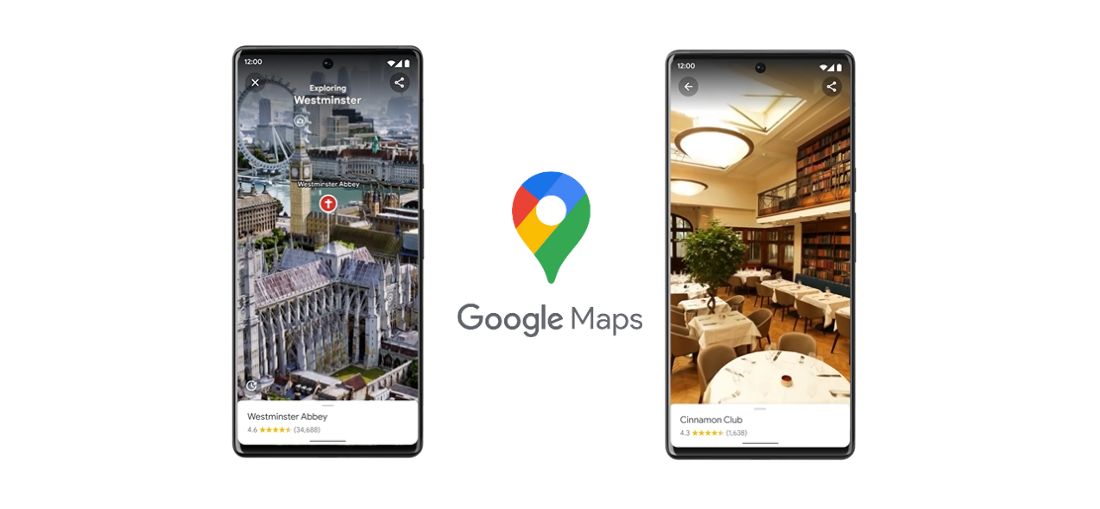Google has announced a number of upgrades to Google Maps. In doing so, the company is demonstrating how artificial intelligence (AI) and augmented reality (AR) can bringing immersive, intuitive maps to life.
Google launches ‘immersive view’
Google’s ‘immersive view’ will provide users with a new way to explore an area. In fact, the company says that it will “let you feel like you’re right there, even before you visit”.
Immersive view works by fusing billions of Street View and aerial images to create a rich, digital model of the world. Layers of information are also added to the images, so users can see information regarding weather, traffic and how busy an area is.
So now, if you’re considering visiting an area on holiday or going somewhere for work, you can virtually soar over any building and see what it looks like (and how busy it is) at any time of day or night. You can also explore at street level and look for nearby restaurants. Once you’ve found somewhere you like the look of, you can even take a look inside to quickly understand the vibe of a spot before you book your reservation.
In order to create true-to-life scenes, Google’s engineers have used neural radiance fields (NeRF), an advanced AI technique, to transform ordinary pictures into 3D representations. This technique allows Google to accurately recreate the full context of a place including its lighting, the texture of materials and what’s in the background.
As of now, immersive view is available in London, Los Angeles, New York, San Francisco and Tokyo. In the coming months, it will become available in even more cities, including in Amsterdam, Dublin, Florence and Venice.
‘Live View’ will allow people to navigate both indoors and outdoors
Google’s ‘Live View’ uses AI and AR to help people find things around them. If you’re using your phone, all you need to do is lift it while you’re on the street to find out more information about a place. Google Maps will then tell you about its opening times, how busy it is and how highly it’s rated.
This feature is available in London, Los Angeles, New York, Paris, San Francisco and Tokyo. In the coming months, it will become available in Barcelona, Dublin and Madrid.
In addition to outdoor use, Google believes that AR can help users navigate tricky places, such as unfamiliar airports. As a result, the company first launched indoor Live View in the US, Zurich and Tokyo in 2021. The feature uses AR-powered arrows to point a user in the right direction and help them find the closest toilets, lounges, taxi stands, car rentals and more with confidence.
Now, the company is embarking on the largest expansion of indoor Live View to date. In the coming months, it will bring the feature to more than 1,000 new airports, train stations and shopping centres in Barcelona, Berlin, Frankfurt, London, Madrid, Melbourne, Paris, Prague, São Paulo, Singapore, Sydney and Taipei.
Google will make driving an electric vehicle easier than ever
On top of this, Google is also introducing new Maps features for electric vehicle drivers who own vehicles with Google built-in. These features include:
- On all trips that require a charging stop, Google will now suggest the best stop based on factors like current traffic, the vehicle’s current charge level and expected energy consumption.
- A ‘very fast’ filter that allows drivers to select stations that have chargers of 150 kilowatts or higher.
- In search results, Google will show whether a specific location (like a supermarket) has a charging station on-site.
Glanceable directions
Finally, Google is making it easier for people to get around… no matter what form of transport they’re taking.
With the help of ‘glanceable directions’, users will be able to track their journey from their route overview or lock screen. Now, users will see updated ETAs and information on when to make their next turn without having to open their phone and using navigation mode in the app. If a user takes another path, Google will update the user’s trip automatically.
These glanceable directions start rolling out globally on Android and iOS in the coming months, and will also be compatible with Live Activities on iOS 16.1.
Why does this matter?
In the past month or so, the news cycle has been dominated by AI, with vast swathes of discussion surrounding ChatGPT and Bard, in particular.
However, while debate swirls around how AI could influence the world of search, these new features give us a practical insight into how AI could provide users with a more immersive, practical and useful way of navigating the world and receiving the information they need.
Author spike.digital
